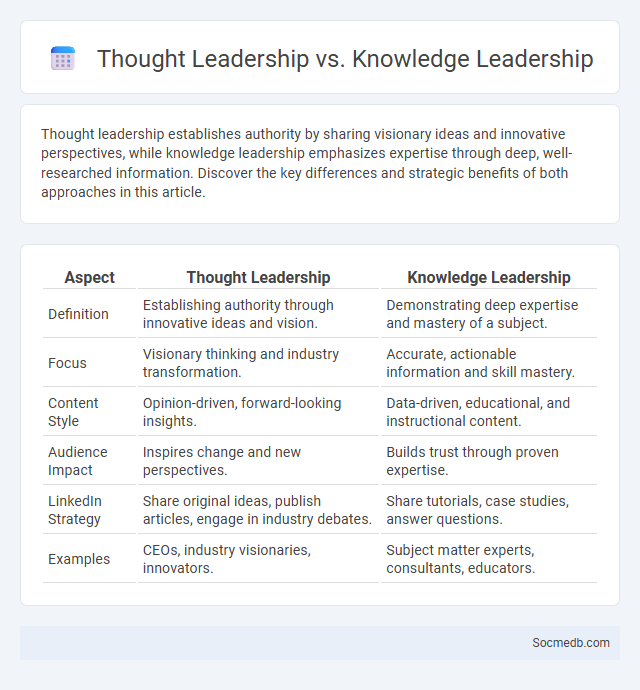
Photo illustration: Thought Leadership vs Knowledge Leadership
Thought leadership establishes authority by sharing visionary ideas and innovative perspectives, while knowledge leadership emphasizes expertise through deep, well-researched information. Discover the key differences and strategic benefits of both approaches in this article.
Table of Comparison
| Aspect | Thought Leadership | Knowledge Leadership |
|---|---|---|
| Definition | Establishing authority through innovative ideas and vision. | Demonstrating deep expertise and mastery of a subject. |
| Focus | Visionary thinking and industry transformation. | Accurate, actionable information and skill mastery. |
| Content Style | Opinion-driven, forward-looking insights. | Data-driven, educational, and instructional content. |
| Audience Impact | Inspires change and new perspectives. | Builds trust through proven expertise. |
| LinkedIn Strategy | Share original ideas, publish articles, engage in industry debates. | Share tutorials, case studies, answer questions. |
| Examples | CEOs, industry visionaries, innovators. | Subject matter experts, consultants, educators. |
Understanding Thought Leadership
Thought leadership on social media involves sharing expert insights and innovative ideas that position you as an authority in your industry. Leveraging platforms like LinkedIn and Twitter, you can amplify Your voice to influence discussions, build trust, and foster meaningful connections with your target audience. Consistent and value-driven content helps establish credibility and distinguishes you from competitors in the digital landscape.
Defining Knowledge Leadership
Knowledge leadership in social media involves positioning You as an authoritative voice by consistently sharing valuable, insightful, and well-researched content that addresses audience needs. Effective knowledge leaders leverage analytics and trending topics to deliver relevant information that enhances credibility and fosters trust among followers. Engaging in thoughtful discussions and providing expert commentary helps maintain Your status as a go-to resource in Your industry.
Key Differences Between Thought and Knowledge Leadership
Thought leadership revolves around sharing innovative ideas and influencing perspectives within your industry, often through original content and visionary insights. Knowledge leadership emphasizes demonstrating expertise and providing detailed, data-driven information to establish credibility and trust with your audience. Understanding these key differences helps you tailor your social media strategy to position yourself effectively as either an industry innovator or a trusted expert.
The Evolution of Leadership Paradigms
The evolution of leadership paradigms in social media has shifted from authoritative command to collaborative influence, emphasizing authenticity and engagement. Modern leaders leverage platforms like LinkedIn, Twitter, and Instagram to foster transparent communication and real-time feedback, enhancing trust and community building. Data-driven insights and social listening tools empower leaders to adapt dynamically, aligning organizational goals with audience expectations.
Elements of Effective Thought Leadership
Effective thought leadership on social media hinges on consistently delivering insightful, well-researched content that resonates with the target audience's needs and interests. Establishing authority requires leveraging a unique voice supported by data-driven insights and credible sources, fostering trust and engagement. Engaging storytelling combined with interactive elements such as polls, Q&A sessions, and multimedia enhances visibility and positions the leader as a go-to expert in their field.
The Role of Knowledge in Leadership
Effective leadership in social media relies heavily on the strategic use of knowledge to shape brand perception, engage audiences, and drive organizational goals. Your ability to analyze data insights and industry trends empowers decision-making that boosts credibility and fosters trust across digital platforms. Leveraging knowledge transforms leaders into influential communicators who can navigate the dynamic social media landscape with confidence.
Building Authority: Thought vs Knowledge Leadership
Building authority on social media requires distinguishing thought leadership from knowledge leadership, where thought leaders inspire innovation by sharing visionary ideas while knowledge leaders establish credibility through expertise and factual insights. Effective content strategies blend original perspectives with data-driven analysis to engage audiences and foster trust. Consistent interaction with followers and demonstrating a deep understanding of industry trends solidify an authoritative presence.
Impact on Industry and Innovation
Social media has revolutionized marketing and customer engagement by enabling real-time interaction and data-driven personalization, significantly boosting brand visibility and sales. The platforms foster innovation through collaborative tools, user-generated content, and accelerated feedback loops that drive rapid product development and creative campaigns. Businesses across industries leverage social media analytics and influencer partnerships to gain competitive advantages and adapt swiftly to changing consumer trends.
Common Misconceptions and Overlaps
Many people believe social media solely serves as a personal communication tool, overlooking its critical role in brand marketing, customer service, and public relations. Common misconceptions include equating follower count with influence, when engagement metrics like comments and shares provide a clearer picture of impact. Your strategic use of social media should address overlaps between platforms to optimize content reach and audience interaction efficiently.
Choosing the Right Leadership Strategy
Selecting the right leadership strategy for social media involves understanding platform-specific audience behaviors and engagement metrics to drive authentic connections. Leveraging data analytics and real-time feedback enables leaders to adapt communication styles that foster community trust and brand loyalty. Prioritizing transparent and inclusive leadership on social channels enhances reputation management and boosts overall digital influence.
 socmedb.com
socmedb.com